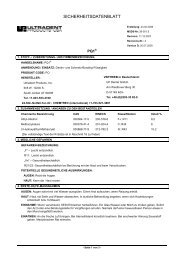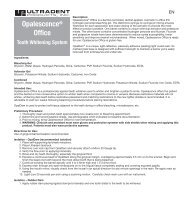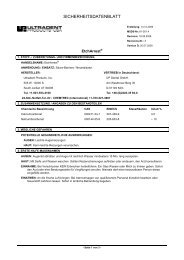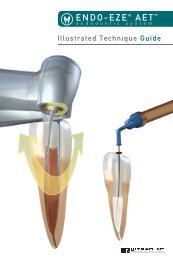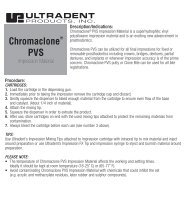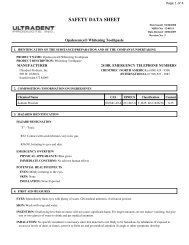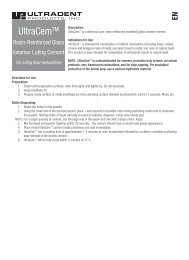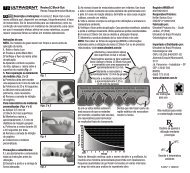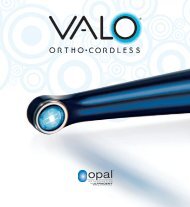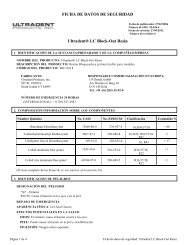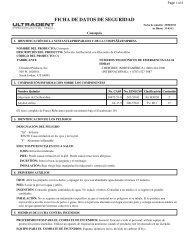ViscoStat®, ViscoStat® Wintermint, Astringedent® & Astringedent ...
ViscoStat®, ViscoStat® Wintermint, Astringedent® & Astringedent ...
ViscoStat®, ViscoStat® Wintermint, Astringedent® & Astringedent ...
You also want an ePaper? Increase the reach of your titles
YUMPU automatically turns print PDFs into web optimized ePapers that Google loves.
NOTE: Ideally, the preparation should be cleaned with a scouring product such as Consepsis Scrub before making the final impression.<br />
9. Remove cord, rinse with a firm air/water spray, check for hemostasis, and make impression.<br />
Directions for Use – Direct Bonded Restorations<br />
1. Follow Steps 1 and 2 in the Impressions section to prepare the syringe.<br />
NOTE: If adequate space at bleeding site allows, follow Steps 3-9 in “Impression” section above.<br />
2. Soak Ultrapak or cord in hemostatic solution.<br />
NOTE: Do not use “Ultrapak E” or other epinephrine preparations with any ferric sulfate hemostatic including ViscoStat, ViscoStat <strong>Wintermint</strong>, <strong>Astringedent</strong>, <strong>Astringedent</strong> X as a blue/<br />
black precipitate will occur.<br />
3. Displace tissue and control sulcular fluid by gently packing size appropriate cord into sulcus.<br />
4. Thoroughly rinse preparation and surrounding tissue using a firm air/water spray to clean and check for hemostasis (Read CLEANSING NOTE below).<br />
5. Scrub preparation surface with pumice or Ultradent’s Consepsis Scrub.<br />
6. Wait 1-3 minutes before removing cord.<br />
NOTE: Cord may be removed or left in place to protect soft tissue.<br />
7. Rinse again with a firm air/water spray and dry. Recommended contact time for Ultradent ferric sulfate hemostatics is 1-3 minutes and up to a maximum of 10-20 minutes.<br />
CLEANSING NOTE: When the tooth is not thoroughly cleaned, residual hemostatic agent or coagulum left on the tooth surface or surrounding tissue may contaminate dentin and/or<br />
enamel substrate jeopardizing the bond and seal causing microleakage. Hemosiderin from residual blood in the sulcus or in the coagulum can move between the restoration and tooth<br />
producing a dark stain on the underlying preparation. This may occur within days or weeks of placing the restoration and will require retreatment and replacements. When using a total<br />
etch phosphoric acid bonding system, the phosphoric acid with help in cleaning the residual hemostatic from the surface however cleaning with a pumice or Consepsis Scrub is always<br />
recommended. When using a self-etch bonding system, the preparation should always be scoured with pumice or Ultradent’s Consepsis Scrub using a rubber cup or STARbrush.<br />
8. Apply bonding agent and restorative as per manufacturer’s instructions.<br />
Directions for Use – Indirect Bonded/Luted Restorations<br />
1. Follow Steps 1-7 for the “Direct Bonded Restorations.” Read and understand “CLEANSING NOTE.”<br />
2. Once preparation is thoroughly clean, proceed with cementing the final restoration.<br />
NOTE: Temporary cements and/or protein mucins from saliva can contaminate preparations. When in mineral-based hemostatics, (i.e. - Ultradent’s ferric sulfate hemostatics) come<br />
in contact with protein mucins, they are more firmly attached to the preparation requiring a more aggressive scour-type cleansing after hemostasis is obtained. To avoid poor bond<br />
strengths and microleakage as explained above in “CLEANSING NOTE”, cleaning with Ultradent’s Consepsis Scrub and a rubber cup or STARbrush should be done prior to taking the<br />
final impression and prior to final cementation.<br />
If dark stain is present on preparations upon removal of the provisional restoration, it is most commonly due to non-sealing provisional cement allowing the hemosiderin to migrate<br />
between the preparation and the provisional restoration. This may occur within days or weeks of placing the provisional restoration. This stain can be very tenacious and requires<br />
firm scrapping and/or ultrasonic instrumentation followed by an aggressive scouring with pumice or Consepsis Scrub, to remove. This problem can be avoided by using a hydrophilic<br />
provisional sealing cement such as UltraTemp regular.<br />
Directions for Use – Vital Pulpotomies (<strong>Astringedent</strong> or ViscoStat ONLY)<br />
1. Follow Steps 1 and 2 in the Impressions section to prepare the syringe.<br />
2. Scrub firmly at site of bleeding. As excess dark coagulum appears, an assistant should express a gentle stream of water over the area and suction.<br />
3. Remove all hemostatic and extraneous coagulum using an excavator, and firm air/water wash. Recommended contact time for Ultradent ferric sulfate hemostatics is 1-3 minutes and<br />
up to a maximum of 10-20 minutes.<br />
4. Apply a thin layer of ZOE, followed by a thin layer of Ultra-Blend Plus keeping both to a minimal thickness so dentin surface is available for bonding.<br />
5. Apply bonding agent and restorative as per manufacturer’s instructions.<br />
2<br />
A71276.11 CS5.indd 2 5/25/12 5:31 PM



